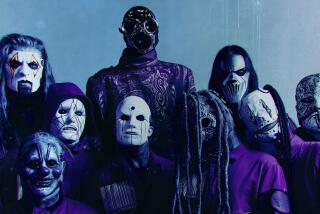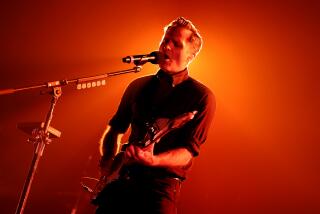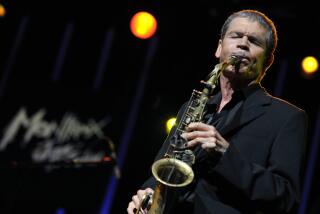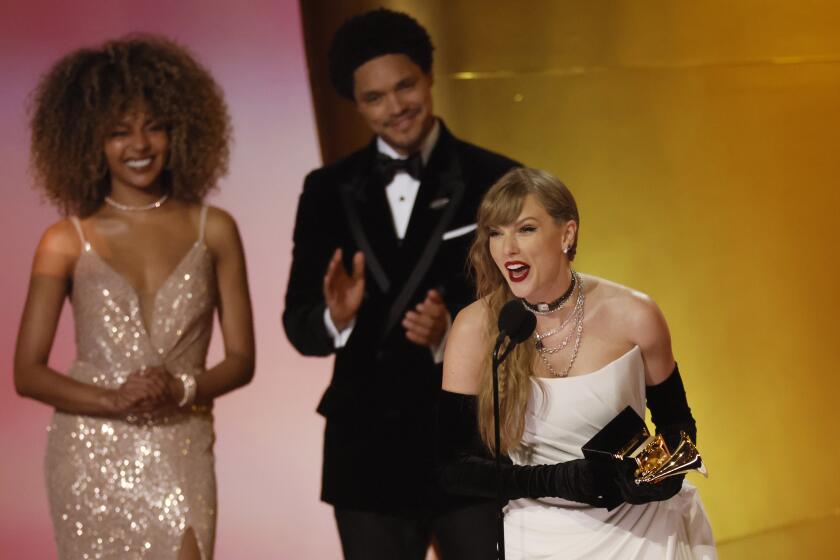SAXMAN SANBORN TAKES CENTER STAGE
- Share via
Alto saxophonist David Sanborn is in the enviable position of being one of the most popular instrumentalists of the day. His latest Warner Bros. album, “A Change of Heart,” is approaching sales of 500,000 and on his current tour--which includes appearances at the Greek Theatre tonight and Thursday--audiences of more than 10,000 fans are not uncommon.
With this kind of success, you might think Sanborn would want to keep on doing what he’s doing. But the 42-year-old horn man says that, for him, his material--much of which is based on pop-type melodies leading to lengthy solos over funk grooves--has lost its bite and it’s time for a change.
“I’ve felt emotionally limited by what I was doing, so I’m trying to open (my style) up a little,” he said by phone from a Denver hotel. “I’ve changed some of the material, doing some of my older tunes like ‘As We Speak’ and ‘Lotus Blossom,’ and I’m also playing ‘God Bless the Child,’ ” which is the first standard Sanborn has offered in either live performances or on record.
But Sanborn says he makes big moves with “lots of baby steps” and this transition will take place slowly, if only because “trying too much new material is hard since I’m promoting (‘A Change of Heart’),” he said. “But I’m starting to move in a different direction. We still do a lot of stuff we were doing, like ‘Chicago Song.’ There are more dynamics (in the show) but it’s still not where I want it.”
Sanborn is looking for a way to put in some of the type of blues-oriented jazz--as played by such saxmen David (Fathead) Newman, Hank Crawford and Cannonball Adderly--which after rock ‘n’ roll, was a seminal influence on the Tampa, Fla., native.
“On my next tour, I’d like to work in some of that older material in its original form,” he said. “With ‘God Bless the Child,’ I’m kind of checking it out, not only seeing what it will do for me, but how the audience reacts. They seem to dig it.
“(The change) is for my musical survival. I can’t keep playing nothing but funk grooves. I’ve got to balance that out. I was searching for a be-bop tune before I started this tour, but I couldn’t find one. Old music doesn’t necessarily translate to now.”
Another factor that makes a substantial move prohibitive is that Sanborn, for the first time in his career, is headlining a major tour. “I play a two-hour show--I’m no longer the SWAT team opening act for Al (Jarreau), where I hit ‘em with my stuff and split,” he said. “This playing in big venues is a whole new thing, and I’m still not comfortable being the front man.”
Sanborn’s discovered that a large audience requires a new approach in itself. “You have to think about the fact that you’re playing in front of 10,000 instead of 500,” he said. “You have to figure out a way to get the stuff across. If something’s subtle, what do I need to do to make it work? I have to balance the show, make it an experience.”
One area of his presentation that Sanborn will not alter is staying away from vocals. “I want the focus of the music to be instrumental,” he said. “If there are any vocals, I want somebody in the band to do it. Heaven forbid I would have a hit with a vocalist. I want people to like music for what it is, not because they want to come and hear the vocal.”
Though a fluent, persuasive soloist who lists such jazzmen as Charlie Parker, Phil Woods and Jackie McLean as influences, Sanborn has never considered himself a jazz player. “Still, since I bridge the gap between pop and rock and instrumental music while basically playing for a pop audience, I think I’m responsible for leading people into mainstream jazz,” he said. “At least that’s what some listeners tell me.”
Sanborn is also creating a new audience for jazz through his syndicated radio show, “The Jazz Show With David Sanborn,” (heard locally on KKGO-FM, (105.1), Sundays at 6 p.m.), where the accent is on the music’s contemporary aspects. “The purpose of the show is to introduce people to jazz on stations that are formatted for rock ‘n’ roll,” he said. “The idea is not to hit them over the head right away, by playing too much mainstream material, yet still maintain some integrity.
“But just because the show is successful (it’s currently on about 150 stations), and as long as its called ‘The Jazz Show’ and my name is on it, we’re going to push the limits a little bit. I mean how can you not play Duke Ellington or Charles Mingus on a jazz show?”
Recently Sanborn’s alto--which has been heard on records with people like James Taylor, David Bowie and Stevie Wonder and is occasionally spotlighted on the “Late Night With David Letterman” show, where he’s a regular band member on Fridays--was featured on the soundtrack to the film, “Lethal Weapon,” but the musician wasn’t enthralled by the experience.
“That’s not what I’m all about,” he said. “I’m just a saxophone player. I like to make records and play live. I guess I should try to think about expanding but I don’t want to expand myself too far. Baby steps, that’s the best way.”
More to Read
The biggest entertainment stories
Get our big stories about Hollywood, film, television, music, arts, culture and more right in your inbox as soon as they publish.
You may occasionally receive promotional content from the Los Angeles Times.










